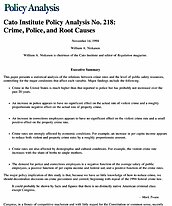This paper presents a statistical analysis of the relations between crime rates and the level of public safety resources, controlling for the major conditions that affect each variable. Major findings include the following.
- Crime in the United States is much higher than that reported to police but has probably not increased over the past 20 years.
- An increase in police appears to have no significant effect on the actual rate of violent crime and a roughly proportionate negative effect on the actual rate of property crime.
- An increase in corrections employees appears to have no significant effect on the violent crime rate and a small positive effect on the property crime rate.
- Crime rates are strongly affected by economic conditions. For example, an increase in per capita income appears to reduce both violent and property crime rates by a roughly proportionate amount.
- Crime rates are also affected by demographic and cultural conditions. For example, the violent crime rate increases with the share of births to single mothers.
- The demand for police and corrections employees is a negative function of the average salary of public employees, a positive function of per capita income and federal aid, and a positive function of the crime rates.
The major policy implication of this study is that, because we have so little knowledge of how to reduce crime, we should decentralize decisions on crime prevention and control, beginning with repeal of the 1994 federal crime law.

This work is licensed under a Creative Commons Attribution-NonCommercial-ShareAlike 4.0 International License.

